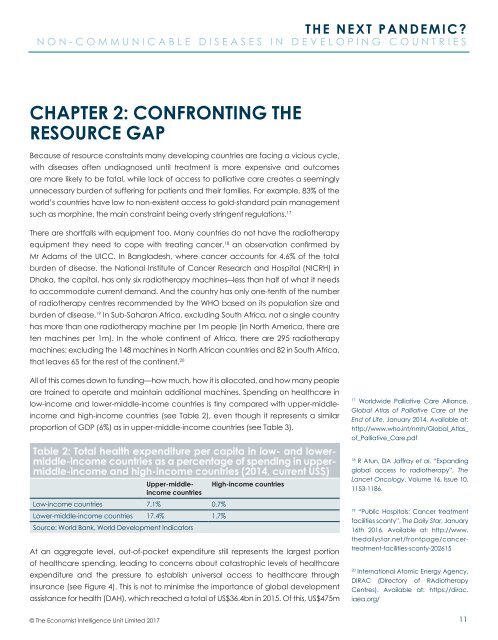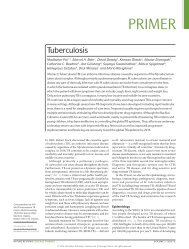THE NEXT PANDEMIC?
The_next_pandemic
The_next_pandemic
You also want an ePaper? Increase the reach of your titles
YUMPU automatically turns print PDFs into web optimized ePapers that Google loves.
<strong>THE</strong> <strong>NEXT</strong> <strong>PANDEMIC</strong>?<br />
NON-COMMUNICABLE DISEASES IN DEVELOPING COUNTRIES<br />
CHAPTER 2: CONFRONTING <strong>THE</strong><br />
RESOURCE GAP<br />
Because of resource constraints many developing countries are facing a vicious cycle,<br />
with diseases often undiagnosed until treatment is more expensive and outcomes<br />
are more likely to be fatal, while lack of access to palliative care creates a seemingly<br />
unnecessary burden of suffering for patients and their families. For example, 83% of the<br />
world’s countries have low to non-existent access to gold-standard pain management<br />
such as morphine, the main constraint being overly stringent regulations. 17<br />
There are shortfalls with equipment too. Many countries do not have the radiotherapy<br />
equipment they need to cope with treating cancer, 18 an observation confirmed by<br />
Mr Adams of the UICC. In Bangladesh, where cancer accounts for 4.6% of the total<br />
burden of disease, the National Institute of Cancer Research and Hospital (NICRH) in<br />
Dhaka, the capital, has only six radiotherapy machines―less than half of what it needs<br />
to accommodate current demand. And the country has only one-tenth of the number<br />
of radiotherapy centres recommended by the WHO based on its population size and<br />
burden of disease. 19 In Sub-Saharan Africa, excluding South Africa, not a single country<br />
has more than one radiotherapy machine per 1m people (in North America, there are<br />
ten machines per 1m). In the whole continent of Africa, there are 295 radiotherapy<br />
machines: excluding the 148 machines in North African countries and 82 in South Africa,<br />
that leaves 65 for the rest of the continent. 20<br />
All of this comes down to funding—how much, how it is allocated, and how many people<br />
are trained to operate and maintain additional machines. Spending on healthcare in<br />
low-income and lower-middle-income countries is tiny compared with upper-middleincome<br />
and high-income countries (see Table 2), even though it represents a similar<br />
proportion of GDP (6%) as in upper-middle-income countries (see Table 3).<br />
Table 2: Total health expenditure per capita in low- and lowermiddle-income<br />
countries as a percentage of spending in uppermiddle-income<br />
and high-income countries (2014, current US$)<br />
Upper-middleincome<br />
High-income countries<br />
countries<br />
Low-income countries 7.1% 0.7%<br />
Lower-middle-income countries 17.4% 1.7%<br />
Source: World Bank, World Development Indicators<br />
At an aggregate level, out-of-pocket expenditure still represents the largest portion<br />
of healthcare spending, leading to concerns about catastrophic levels of healthcare<br />
expenditure and the pressure to establish universal access to healthcare through<br />
insurance (see Figure 4). This is not to minimise the importance of global development<br />
assistance for health (DAH), which reached a total of US$36.4bn in 2015. Of this, US$475m<br />
17<br />
Worldwide Palliative Care Alliance,<br />
Global Atlas of Palliative Care at the<br />
End of Life, January 2014. Available at:<br />
http://www.who.int/nmh/Global_Atlas_<br />
of_Palliative_Care.pdf<br />
18<br />
R Atun, DA Jaffray et al, “Expanding<br />
global access to radiotherapy”, The<br />
Lancet Oncology, Volume 16, Issue 10,<br />
1153-1186.<br />
19<br />
“Public Hospitals: Cancer treatment<br />
facilities scanty”, The Daily Star, January<br />
16th 2016. Available at: http://www.<br />
thedailystar.net/frontpage/cancertreatment-facilities-scanty-202615<br />
20<br />
International Atomic Energy Agency,<br />
DIRAC (DIrectory of RAdiotherapy<br />
Centres). Available at: https://dirac.<br />
iaea.org/<br />
© The Economist Intelligence Unit Limited 2017<br />
11




